Efficacy of the Immobilized Kocuria flava Lipase on Fe3O4/Cellulose Nanocomposite for Biodiesel Production from Cooking Oil Wastes
Abstract
:1. Introduction
2. Results
2.1. Production and Purification of Kocuria flava ASU5 Lipase
2.2. Synthesis and Characterization of Nanocomposite and Immobilization of Kocuria flava ASU5 Lipases
2.3. Characterization of Partially Purified Free Kocuria flava ASU5 Lipase and Immobilized Lipases
2.3.1. Effect of Reaction Temperature
2.3.2. Effect of Hydrogen Ion Concentration
2.3.3. Assay of Thermo-Stability
2.4. Kinetics of the Immobilized Lipase Enzyme
2.5. The Efficiency of Biodiesel Synthesis and the Reusability of the Immobilized Lipase
2.6. Properties of Obtained Biodiesel from Immobilized Lipase Transesterification/Esterification Process
3. Discussion
3.1. Production and Purification of Kocuria flava ASU5 Lipase
3.2. Synthesis and Characterization of Nanocomposite and Immobilization of Kocuria flava ASU5 Lipases
3.3. Characterization of Partially Purified Free Kocuria flava ASU5 Lipase and Immobilized Lipases
3.3.1. Effect of Reaction Temperature
3.3.2. Effect of Hydrogen Ion Concentration
3.3.3. Assay of Thermo-Stability and Immobilized Enzyme Kinetics
3.4. The Efficiency for Biodiesel Synthesis and the Reusability of the Immobilized Lipase
4. Materials and Methods
4.1. Kocuria flava Lipase Enzyme Production
4.2. Preparation of Nanocomposite
4.2.1. Materials
4.2.2. Synthesis of Fe3O4 Nanoparticles (NPs)
4.2.3. Preparation of Cellulosic Nanomaterials from Waste Papers
4.2.4. Preparation of Fe3O4 Magnetic-Cellulosic Nanocomposites
4.3. Immobilization of Lipase Enzyme with Fe3O4 Magnetic-Cellulosic Nanocomposites
4.4. Optimization and Characterization of the Lipase Enzyme Activity
4.5. Kinetics of Immobilized Enzyme Reusability
4.6. Assay for Immobilized Enzyme Reusability
4.7. Biodiesel Production from Waste Oil by Immobilized Lipase Enzyme
4.8. Determination of the Physicochemical Characteristics
- ci = the concentration (mass fraction)
- ρi = the density of component (individual the fatty acid methyl ester) present in the biodiesel
- νmix = the kinematic viscosity of the biodiesel sample (the mixture of fatty acid alkyl esters),
- Ac = the relative amount (%/100) of the individual neat ester in the mixture (as determined by, GC/Ms)
- νc= obtained from the kinematic viscosity database of the individual FAME present in biodiesel
- Ai = the percentage,
- D = the number of the double bonds
- MWi = the molecular mass of each fatty acid methyl ester
- CNi = reported CN of pure fatty acid methyl esters available in the database
- Wi = the mass fraction of the individual fatty ester components detected and quantified by GC/MS.
5. Conclusions
Author Contributions
Funding
Data Availability Statement
Acknowledgments
Conflicts of Interest
References
- Goldemberg, J. Ethanol for a Sustainable Energy Future. Science 2007, 315, 808–810. [Google Scholar] [CrossRef] [PubMed]
- Uddin, W. Mobile and Area Sources of Greenhouse Gases and Abatement Strategies BT—Handbook of Climate Change Mitigation and Adaptation; Lackner, M., Sajjadi, B., Chen, W.-Y., Eds.; Springer International Publishing: Cham, Switzerland, 2022; pp. 743–807. ISBN 978-3-030-72579-2. [Google Scholar]
- Hawkes, F.R.; Dinsdale, R.; Hawkes, D.L.; Hussy, I. Sustainable Fermentative Hydrogen Production: Challenges for Process Optimisation. Int. J. Hydrogen Energy 2002, 27, 1339–1347. [Google Scholar] [CrossRef]
- Afolalu, S.A.; Yusuf, O.O.; Abioye, A.A.; Emetere, M.E.; Ongbali, S.O.; Samuel, O.D. Biofuel; A Sustainable Renewable Source Of Energy-A Review. IOP Conf. Ser. Earth Environ. Sci. 2021, 665, 12040. [Google Scholar] [CrossRef]
- Hassan, E.A.; Abd-Alla, M.H.; Bagy, M.M.K.; Morsy, F.M. In Situ Hydrogen, Acetone, Butanol, Ethanol and Microdiesel Production by Clostridium acetobutylicum ATCC 824 from Oleaginous Fungal Biomass. Anaerobe 2015, 34, 125–131. [Google Scholar] [CrossRef]
- Califano, V.; Bloisi, F.; Perretta, G.; Aronne, A.; Ausanio, G.; Costantini, A.; Vicari, L. Frozen Microemulsions for MAPLE Immobilization of Lipase. Molecules 2017, 22, 2153. [Google Scholar] [CrossRef]
- Meher, L.C.; Vidya Sagar, D.; Naik, S.N. Technical Aspects of Biodiesel Production by Transesterification—A Review. Renew. Sustain. Energy Rev. 2006, 10, 248–268. [Google Scholar] [CrossRef]
- Amini, Z.; Ilham, Z.; Ong, H.C.; Mazaheri, H.; Chen, W.-H. State of the Art and Prospective of Lipase-Catalyzed Transesterification Reaction for Biodiesel Production. Energy Convers. Manag. 2017, 141, 339–353. [Google Scholar] [CrossRef]
- Sankaran, R.; Show, P.L.; Chang, J.-S. Biodiesel Production Using Immobilized Lipase: Feasibility and Challenges. Biofuels Bioprod. Biorefin. 2016, 10, 896–916. [Google Scholar] [CrossRef]
- Xie, W.; Huang, M. Immobilization of Candida Rugosa Lipase onto Graphene Oxide Fe3O4 Nanocomposite: Characterization and Application for Biodiesel Production. Energy Convers. Manag. 2018, 159, 42–53. [Google Scholar] [CrossRef]
- Dhawane, S.H.; Chowdhury, S.; Halder, G. Lipase Immobilised Carbonaceous Catalyst Assisted Enzymatic Transesterification of Mesua ferrea Oil. Energy Convers. Manag. 2019, 184, 671–680. [Google Scholar] [CrossRef]
- Cipolatti, E.P.; Valério, A.; Henriques, R.O.; Moritz, D.E.; Ninow, J.L.; Freire, D.M.G.; Manoel, E.A.; Fernandez-Lafuente, R.; de Oliveira, D. Nanomaterials for Biocatalyst Immobilization—State of the Art and Future Trends. RSC Adv. 2016, 6, 104675–104692. [Google Scholar] [CrossRef]
- Garcia-Galan, C.; Berenguer-Murcia, Á.; Fernandez-Lafuente, R.; Rodrigues, R.C. Potential of Different Enzyme Immobilization Strategies to Improve Enzyme Performance. Adv. Synth. Catal. 2011, 353, 2885–2904. [Google Scholar] [CrossRef]
- Xie, W.; Zang, X. Lipase Immobilized on Ionic Liquid-Functionalized Magnetic Silica Composites as a Magnetic Biocatalyst for Production of Trans-Free Plastic Fats. Food Chem. 2018, 257, 15–22. [Google Scholar] [CrossRef]
- Khoshnevisan, K.; Bordbar, A.-K.; Zare, D.; Davoodi, D.; Noruzi, M.; Barkhi, M.; Tabatabaei, M. Immobilization of Cellulase Enzyme on Superparamagnetic Nanoparticles and Determination of Its Activity and Stability. Chem. Eng. J. 2011, 171, 669–673. [Google Scholar] [CrossRef]
- Xie, W.; Zang, X. Covalent Immobilization of Lipase onto Aminopropyl-Functionalized Hydroxyapatite-Encapsulated-γ-Fe2O3 Nanoparticles: A Magnetic Biocatalyst for Interesterification of Soybean Oil. Food Chem. 2017, 227, 397–403. [Google Scholar] [CrossRef] [PubMed]
- Xie, W.; Huang, M. Fabrication of Immobilized Candida rugosa Lipase on Magnetic Fe3O4-Poly(Glycidyl Methacrylate-Co-Methacrylic Acid) Composite as an Efficient and Recyclable Biocatalyst for Enzymatic Production of Biodiesel. Renew. Energy 2020, 158, 474–486. [Google Scholar] [CrossRef]
- Ren, Y.; Rivera, J.G.; He, L.; Kulkarni, H.; Lee, D.-K.; Messersmith, P.B. Facile, High Efficiency Immobilization of Lipase Enzyme on Magnetic Iron Oxide Nanoparticles via a Biomimetic Coating. BMC Biotechnol. 2011, 11, 63. [Google Scholar] [CrossRef]
- Karimi, M. Immobilization of Lipase onto Mesoporous Magnetic Nanoparticles for Enzymatic Synthesis of Biodiesel. Biocatal. Agric. Biotechnol. 2016, 8, 182–188. [Google Scholar] [CrossRef]
- Xie, W.; Wang, J. Enzymatic Production of Biodiesel from Soybean Oil by Using Immobilized Lipase on Fe3O4/Poly(Styrene-Methacrylic Acid) Magnetic Microsphere as a Biocatalyst. Energy Fuels 2014, 28, 2624–2631. [Google Scholar] [CrossRef]
- Qiao, J.; Wang, T.; Zheng, K.; Zhou, E.; Shen, C.; Jia, A.; Zhang, Q. Magnetically Reusable Fe3O4@NC@Pt Catalyst for Selective Reduction of Nitroarenes. Catalysts 2021, 11, 1219. [Google Scholar] [CrossRef]
- Polshettiwar, V.; Varma, R.S. Green Chemistry by Nano-Catalysis. Green Chem. 2010, 12, 743–754. [Google Scholar] [CrossRef]
- Xia, H.; Cui, B.; Zhou, J.; Zhang, L.; Zhang, J.; Guo, X.; Guo, H. Synthesis and Characterization of Fe3O4@C@Ag Nanocomposites and Their Antibacterial Performance. Appl. Surf. Sci. 2011, 257, 9397–9402. [Google Scholar] [CrossRef]
- Nasrollahzadeh, M.; Mohammad Sajadi, S.; Rostami-Vartooni, A.; Khalaj, M. Green Synthesis of Pd/Fe3O4 Nanoparticles Using Euphorbia Condylocarpa M. Bieb Root Extract and Their Catalytic Applications as Magnetically Recoverable and Stable Recyclable Catalysts for the Phosphine-Free Sonogashira and Suzuki Coupling Reactions. J. Mol. Catal. A Chem. 2015, 396, 31–39. [Google Scholar] [CrossRef]
- Atarod, M.; Nasrollahzadeh, M.; Sajadi, S.M. Green Synthesis of a Cu/Reduced Graphene Oxide/Fe3O4 Nanocomposite Using Euphorbia wallichii Leaf Extract and Its Application as a Recyclable and Heterogeneous Catalyst for the Reduction of 4-Nitrophenol and Rhodamine B. RSC Adv. 2015, 5, 91532–91543. [Google Scholar] [CrossRef]
- Ghazanfari, M.R.; Kashefi, M.; Shams, S.F.; Jaafari, M.R. Perspective of Fe3O4 Nanoparticles Role in Biomedical Applications. Biochem. Res. Int. 2016, 2016, 7840161. [Google Scholar] [CrossRef]
- Ullah, K.; Ahmad, M.; Sultana, S.; Teong, L.K.; Sharma, V.K.; Abdullah, A.Z.; Zafar, M.; Ullah, Z. Experimental Analysis of Di-Functional Magnetic Oxide Catalyst and Its Performance in the Hemp Plant Biodiesel Production. Appl. Energy 2014, 113, 660–669. [Google Scholar] [CrossRef]
- Zhang, F.; Fang, Z.; Wang, Y.-T. Biodiesel Production Directly from Oils with High Acid Value by Magnetic Na2SiO3@Fe3O4/C Catalyst and Ultrasound. Fuel 2015, 150, 370–377. [Google Scholar] [CrossRef]
- Serga, V.; Burve, R.; Maiorov, M.; Krumina, A.; Skaudžius, R.; Zarkov, A.; Kareiva, A.; Popov, A.I. Impact of Gadolinium on the Structure and Magnetic Properties of Nanocrystalline Powders of Iron Oxides Produced by the Extraction-Pyrolytic Method. Materials 2020, 13, 4147. [Google Scholar] [CrossRef]
- Li, Y.; Wang, Z.; Liu, R. Superparamagnetic α-Fe2O3/Fe3O4 Heterogeneous Nanoparticles with Enhanced Biocompatibility. Nanomaterials 2021, 11, 834. [Google Scholar] [CrossRef]
- Niculescu, A.-G.; Chircov, C.; Grumezescu, A.M. Magnetite Nanoparticles: Synthesis Methods—A Comparative Review. Methods 2022, 199, 16–27. [Google Scholar] [CrossRef]
- Helmiyati, H.; Anggraini, Y. Nanocomposites Comprising Cellulose and Nanomagnetite as Heterogeneous Catalysts for the Synthesis of Biodiesel from Oleic Acid. Int. J. Technol. 2019, 10, 798. [Google Scholar] [CrossRef]
- Costantini, A.; Califano, V. Lipase Immobilization in Mesoporous Silica Nanoparticles for Biofuel Production. Catalysts 2021, 11, 629. [Google Scholar] [CrossRef]
- Najjar, A.; Hassan, E.; Zabermawi, N.; Hassan, S.; Bajrai, L.; Almuhayawi, M.; Abujamel, T.; Almasaudi, S.; Azhar, L.; Moulay, M.; et al. Optimizing the Catalytic Activities of Methanol and Thermotolerant Kocuria flava Lipases for Biodiesel Production from Cooking Oil Wastes. Sci. Rep. 2021, 11, 13659. [Google Scholar] [CrossRef] [PubMed]
- Garlapati, V.K.; Kant, R.; Kumari, A.; Mahapatra, P.; Das, P.; Banerjee, R. Lipase Mediated Transesterification of Simarouba glauca Oil: A New Feedstock for Biodiesel Production. Sustain. Chem. Process. 2013, 1, 11. [Google Scholar] [CrossRef]
- Islam, A.; Taufiq-Yap, Y.H.; Chan, E.-S.; Moniruzzaman, M.; Islam, S.; Nabi, M.N. Advances in Solid-Catalytic and Non-Catalytic Technologies for Biodiesel Production. Energy Convers. Manag. 2014, 88, 1200–1218. [Google Scholar] [CrossRef]
- Gog, A.; Roman, M.; Toşa, M.; Paizs, C.; Irimie, F.D. Biodiesel Production Using Enzymatic Transesterification—Current State and Perspectives. Renew. Energy 2012, 39, 10–16. [Google Scholar] [CrossRef]
- Macario, A.; Moliner, M.; Diaz, U.; Jorda, J.L.; Corma, A.; Giordano, G. Biodiesel Production by Immobilized Lipase on Zeolites and Related Materials. In Zeolites and Related Materials: Trends, Targets and Challenges; Gédéon, A., Massiani, P., Babonneau, F., Eds.; Elsevier: Amsterdam, The Netherlands, 2008; Volume 174, pp. 1011–1016. ISBN 0167-2991. [Google Scholar]
- Gupta, A.K.; Gupta, M. Synthesis and Surface Engineering of Iron Oxide Nanoparticles for Biomedical Applications. Biomaterials 2005, 26, 3995–4021. [Google Scholar] [CrossRef]
- Sheldon, R.A. Enzyme Immobilization: The Quest for Optimum Performance. Adv. Synth. Catal. 2007, 349, 1289–1307. [Google Scholar] [CrossRef]
- Daniel, M.-C.; Astruc, D. Gold Nanoparticles: Assembly, Supramolecular Chemistry, Quantum-Size-Related Properties, and Applications toward Biology, Catalysis, and Nanotechnology. Chem. Rev. 2004, 104, 293–346. [Google Scholar] [CrossRef]
- Jung, U.-Y.; Park, J.-W.; Han, E.-H.; Kang, S.-G.; Lee, S.; Jun, C.-H. Facile One-Step Catalytic Grafting of N-Hydroxysuccinimidyl-Ester-Functionalized Methallylsilane onto Silica for Enzyme Immobilization. Chem.—Asian J. 2011, 6, 638–645. [Google Scholar] [CrossRef]
- Tsai, T.-W.; Heckert, G.; Neves, L.F.; Tan, Y.; Kao, D.-Y.; Harrison, R.G.; Resasco, D.E.; Schmidtke, D.W. Adsorption of Glucose Oxidase onto Single-Walled Carbon Nanotubes and Its Application in Layer-By-Layer Biosensors. Anal. Chem. 2009, 81, 7917–7925. [Google Scholar] [CrossRef] [PubMed]
- Lai, J.-Q.; Hu, Z.-L.; Sheldon, R.A.; Yang, Z. Catalytic Performance of Cross-Linked Enzyme Aggregates of Penicillium expansum Lipase and Their Use as Catalyst for Biodiesel Production. Process Biochem. 2012, 47, 2058–2063. [Google Scholar] [CrossRef]
- Sivaramakrishnan, R.; Muthukumar, K. Isolation of Thermo-Stable and Solvent-Tolerant Bacillus sp. Lipase for the Production of Biodiesel. Appl. Biochem. Biotechnol. 2012, 166, 1095–1111. [Google Scholar] [CrossRef]
- Li, Z.; Yuan, H.; Yang, J.; Li, B. Optimization of the Biomass Production of Oil Algae Chlorella minutissima UTEX2341. Bioresour. Technol. 2011, 102, 9128–9134. [Google Scholar] [CrossRef] [PubMed]
- Tran, D.-T.; Chen, C.-L.; Chang, J.-S. Effect of Solvents and Oil Content on Direct Transesterification of Wet Oil-Bearing Microalgal Biomass of Chlorella vulgaris ESP-31 for Biodiesel Synthesis Using Immobilized Lipase as the Biocatalyst. Bioresour. Technol. 2013, 135, 213–221. [Google Scholar] [CrossRef]
- Zavareh, S.; Behrouzi, Z.; Avanes, A. Cu (II) Binded Chitosan/Fe3O4 Nanocomomposite as a New Biosorbent for Efficient and Selective Removal of Phosphate. Int. J. Biol. Macromol. 2017, 101, 40–50. [Google Scholar] [CrossRef]
- Wei, Y.; Han, B.; Hu, X.; Lin, Y.; Wang, X.; Deng, X. Synthesis of Fe3O4 Nanoparticles and Their Magnetic Properties. Procedia Eng. 2012, 27, 632–637. [Google Scholar] [CrossRef]
- Pham, X.N.; Nguyen, T.P.; Pham, T.N.; Tran, T.T.N.; Tran, T.V.T. Synthesis and Characterization of Chitosan-Coated Magnetite Nanoparticles and Their Application in Curcumin Drug Delivery. Adv. Nat. Sci. Nanosci. Nanotechnol. 2016, 7, 45010. [Google Scholar] [CrossRef]
- Pati, S.S.; Mahendran, V.; Philip, J. A Simple Approach to Produce Stable Ferrofluids without Surfactants and with High Temperature Stability. J. Nanofluids 2013, 2, 94–103. [Google Scholar] [CrossRef]
- Leung, A.C.W.; Hrapovic, S.; Lam, E.; Liu, Y.; Male, K.B.; Mahmoud, K.A.; Luong, J.H.T. Characteristics and Properties of Carboxylated Cellulose Nanocrystals Prepared from a Novel One-Step Procedure. Small 2011, 7, 302–305. [Google Scholar] [CrossRef] [Green Version]
- Şengül, G.; Demirci, S.; Caykara, T. Preparation, Characterization, and Surface Energetics of Hydroxypropyl Cellulose/Polyethylenimine Blends. J. Appl. Polym. Sci. 2009, 114, 2751–2754. [Google Scholar] [CrossRef]
- Xie, W.; Huang, M. Enzymatic Production of Biodiesel Using Immobilized Lipase on Core-Shell Structured Fe3O4@MIL-100(Fe) Composites. Catalys 2019, 9, 850. [Google Scholar] [CrossRef]
- Zhang, D.-H.; Peng, L.-J.; Wang, Y.; Li, Y.-Q. Lipase Immobilization on Epoxy-Activated Poly(Vinyl Acetate-Acrylamide) Microspheres. Colloids Surf. B Biointerfaces 2015, 129, 206–210. [Google Scholar] [CrossRef]
- Kim, H.; Namgung, R.; Singha, K.; Oh, I.-K.; Kim, W.J. Graphene Oxide–Polyethylenimine Nanoconstruct as a Gene Delivery Vector and Bioimaging Tool. Bioconjug. Chem. 2011, 22, 2558–2567. [Google Scholar] [CrossRef] [PubMed]
- Tischer, W.; Wedekind, F. Immobilized Enzymes: Methods and Applications; Fessner, W.-D., Archelas, A., Demirjian, D.C., Furstoss, R., Griengl, H., Jaeger, K.-E., Morís-Varas, E., Öhrlein, R., Reetz, M.T., Reymond, J.-L., et al., Eds.; Springer: Berlin/Heidelberg, Germany, 1999; pp. 95–126. ISBN 978-3-540-68116-8. [Google Scholar]
- Wang, W.; Li, H.-Y.; Zhang, D.-W.; Jiang, J.; Cui, Y.-R.; Qiu, S.; Zhou, Y.-L.; Zhang, X.-X. Fabrication of Bienzymatic Glucose Biosensor Based on Novel Gold Nanoparticles-Bacteria Cellulose Nanofibers Nanocomposite. Electroanalysis 2010, 22, 2543–2550. [Google Scholar] [CrossRef]
- Zhang, T.; Wang, W.; Zhang, D.; Zhang, X.; Ma, Y.; Zhou, Y.; Qi, L. Biotemplated Synthesis of Gold Nanoparticle–Bacteria Cellulose Nanofiber Nanocomposites and Their Application in Biosensing. Adv. Funct. Mater. 2010, 20, 1152–1160. [Google Scholar] [CrossRef]
- Mahmoud, K.A.; Male, K.B.; Hrapovic, S.; Luong, J.H.T. Cellulose Nanocrystal/Gold Nanoparticle Composite as a Matrix for Enzyme Immobilization. ACS Appl. Mater. Interfaces 2009, 1, 1383–1386. [Google Scholar] [CrossRef] [PubMed]
- Lu, P.; Hsieh, Y.-L. Preparation and Properties of Cellulose Nanocrystals: Rods, Spheres, and Network. Carbohydr. Polym. 2010, 82, 329–336. [Google Scholar] [CrossRef]
- Jackson, J.K.; Letchford, K.; Wasserman, B.Z.; Ye, L.; Hamad, W.Y.; Burt, H.M. The Use of Nanocrystalline Cellulose for the Binding and Controlled Release of Drugs. Int. J. Nanomed. 2011, 6, 321–330. [Google Scholar] [CrossRef]
- Arola, S.; Tammelin, T.; Setälä, H.; Tullila, A.; Linder, M.B. Immobilization–Stabilization of Proteins on Nanofibrillated Cellulose Derivatives and Their Bioactive Film Formation. Biomacromolecules 2012, 13, 594–603. [Google Scholar] [CrossRef]
- Orelma, H.; Teerinen, T.; Johansson, L.-S.; Holappa, S.; Laine, J. CMC-Modified Cellulose Biointerface for Antibody Conjugation. Biomacromolecules 2012, 13, 1051–1058. [Google Scholar] [CrossRef] [PubMed]
- Hu, X.; Wang, T.; Qu, X.; Dong, S. In Situ Synthesis and Characterization of Multiwalled Carbon Nanotube/Au Nanoparticle Composite Materials. J. Phys. Chem. B 2006, 110, 853–857. [Google Scholar] [CrossRef] [PubMed]
- Sooch, B.; Kauldhar, B. Influence of Multiple Bioprocess Parameters on Production of Lipase from Pseudomonas sp. BWS-5. Braz. Arch. Biol. Technol. 2013, 56, 711–721. [Google Scholar] [CrossRef]
- Priyanka, P.; Kinsella, G.; Henehan, G.T.; Ryan, B.J. Isolation, Purification and Characterization of a Novel Solvent Stable Lipase from Pseudomonas reinekei. Protein Expr. Purif. 2019, 153, 121–130. [Google Scholar] [CrossRef] [PubMed]
- Sharma, A.K.; Tiwari, R.P.; Hoondal, G.S. Properties of a Thermostable and Solvent Stable Extracellular Lipase from a Pseudomonas sp. AG-8. J. Basic Microbiol. 2001, 41, 363–366. [Google Scholar] [CrossRef]
- Talley, K.; Alexov, E. On the PH-Optimum of Activity and Stability of Proteins. Proteins Struct. Funct. Bioinform. 2010, 78, 2699–2706. [Google Scholar] [CrossRef]
- Talòn, R.; Dublet, N.; Montel, M.-C.; Cantonnet, M. Purification and Characterization of Extracellular Staphylococcus warneri Lipase. Curr. Microbiol. 1995, 30, 11–16. [Google Scholar] [CrossRef]
- Rosenstein, R.; Götz, F. Staphylococcal Lipases: Biochemical and Molecular Characterization. Biochimie 2000, 82, 1005–1014. [Google Scholar] [CrossRef]
- Shah, K. Purification and Characterization of Lipase from B. subtilis Pa2. J. Biochem. Technol. 2012, 3, 292–295. [Google Scholar]
- Sztajer, H.; Borkowski, J.; Sobiech, K. Purification and Some Properties of Pseudomonas fluorescens Lipase. Biotechnol. Appl. Biochem. 1991, 13, 65–71. [Google Scholar] [CrossRef]
- Yasar, G.; Gulhan, U.G.; Guduk, E.; Aktas, F. Screening, Partial Purification and Characterization of the Hyper-Thermophilic Lipase Produced by a New Isolate of Bacillus subtilis LP2. Biocatal. Biotransform. 2020, 38, 367–375. [Google Scholar] [CrossRef]
- Abol-Fotouh, D.; AlHagar, O.E.A.; Hassan, M.A. Optimization, Purification, and Biochemical Characterization of Thermoalkaliphilic Lipase from a Novel Geobacillus stearothermophilus FMR12 for Detergent Formulations. Int. J. Biol. Macromol. 2021, 181, 125–135. [Google Scholar] [CrossRef] [PubMed]
- Baral, A.; Fox, P.F. Isolation and Characterization of an Extracellular Lipase from Pseudomonas tolaasii. Food Chem. 1997, 58, 33–38. [Google Scholar] [CrossRef]
- Demirbas, A. Biodiesel Production from Vegetable Oils via Catalytic and Non-Catalytic Supercritical Methanol Transesterification Methods. Prog. Energy Combust. Sci. 2005, 31, 466–487. [Google Scholar] [CrossRef]
- Ramalingam, S.; Sudagar, S.; Balamurugan, R.; Naveen, R. Performance and Emission Behavior of Biofuel from Milk Scum: A Waste Product from Dairy Industry. Energy Sources Part A Recover. Util. Environ. Eff. 2021, 43, 968–976. [Google Scholar] [CrossRef]
- Balat, M. Potential Alternatives to Edible Oils for Biodiesel Production—A Review of Current Work. Energy Convers. Manag. 2011, 52, 1479–1492. [Google Scholar] [CrossRef]
- Diya’uddeen, B.H.; Abdul Aziz, A.R.; Daud, W.M.A.W.; Chakrabarti, M.H. Performance Evaluation of Biodiesel from Used Domestic Waste Oils: A Review. Process Saf. Environ. Prot. 2012, 90, 164–179. [Google Scholar] [CrossRef]
- Selvaraj, R.; Praveenkumar, R.; Moorthy, I.G. A Comprehensive Review of Biodiesel Production Methods from Various Feedstocks. Biofuels 2019, 10, 325–333. [Google Scholar] [CrossRef]
- Yaakob, Z.; Mohammad, M.; Alherbawi, M.; Alam, Z.; Sopian, K. Overview of the Production of Biodiesel from Waste Cooking Oil. Renew. Sustain. Energy Rev. 2013, 18, 184–193. [Google Scholar] [CrossRef]
- Tripathi, R.; Singh, J.; Bharti, R.K.; Thakur, I.S. Isolation, Purification and Characterization of Lipase from Microbacterium sp. and Its Application in Biodiesel Production. Energy Procedia 2014, 54, 518–529. [Google Scholar] [CrossRef]
- Lowry, O.H.; Rosebrough, N.J.; Farr, A.L.; Randall, R.J. Protein Measurement with the Folin Phenol Reagent. J. Biol. Chem. 1951, 193, 265–275. [Google Scholar] [CrossRef]
- Ault, A. An Introduction to Enzyme Kinetics. J. Chem. Educ. 1974, 51, 381. [Google Scholar] [CrossRef]
- Pratas, M.J.; Freitas, S.V.D.; Oliveira, M.B.; Monteiro, S.C.; Lima, Á.S.; Coutinho, J.A.P. Biodiesel Density: Experimental Measurements and Prediction Models. Energy Fuels 2011, 25, 2333–2340. [Google Scholar] [CrossRef]
- Lapuerta, M.; Rodríguez-Fernández, J.; Armas, O. Correlation for the Estimation of the Density of Fatty Acid Esters Fuels and Its Implications. A Proposed Biodiesel Cetane Index. Chem. Phys. Lipids 2010, 163, 720–727. [Google Scholar] [CrossRef]
- Knothe, G.; Steidley, K.R. Kinematic Viscosity of Fatty Acid Methyl Esters: Prediction, Calculated Viscosity Contribution of Esters with Unavailable Data, and Carbon–Oxygen Equivalents. Fuel 2011, 90, 3217–3224. [Google Scholar] [CrossRef]
- Mohibbe Azam, M.; Waris, A.; Nahar, N.M. Prospects and Potential of Fatty Acid Methyl Esters of Some Non-Traditional Seed Oils for Use as Biodiesel in India. Biomass Bioenergy 2005, 29, 293–302. [Google Scholar] [CrossRef]
- Gunstone, F.D.; Harwood, J.L.; Dijkstra, A.J. The Lipid Handbook with CD-ROM, 3rd ed.; CRC/Taylor & Francis: Boca Raton, FL, USA, 2007; ISBN 9781420009675. [Google Scholar]
- Demirbaş, A. Fuel Properties and Calculation of Higher Heating Values of Vegetable Oils. Fuel 1998, 77, 1117–1120. [Google Scholar] [CrossRef]
- Tong, D.; Hu, C.; Jiang, K.; Li, Y. Cetane Number Prediction of Biodiesel from the Composition of the Fatty Acid Methyl Esters. J. Am. Oil Chem. Soc. 2011, 88, 415–423. [Google Scholar] [CrossRef]
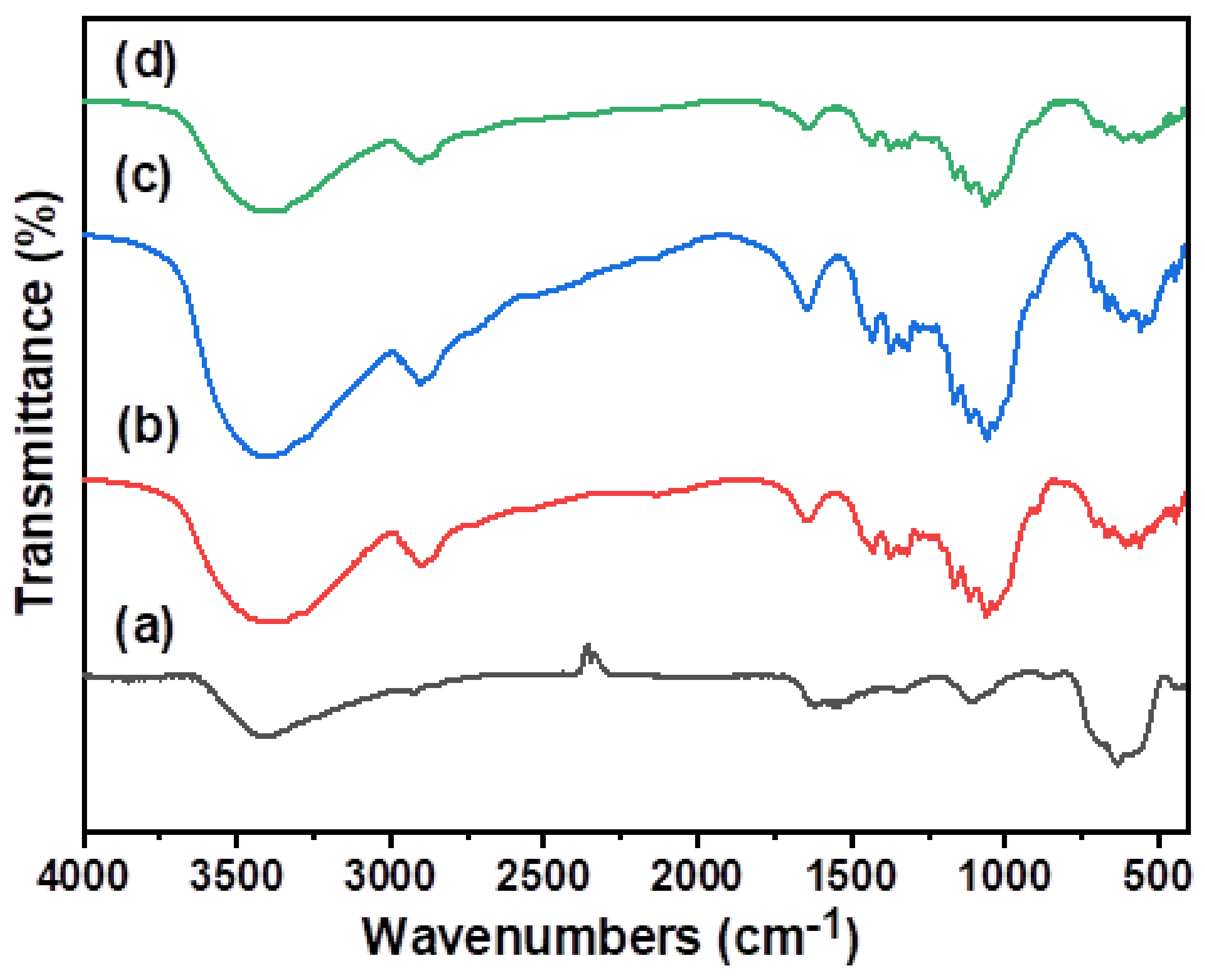

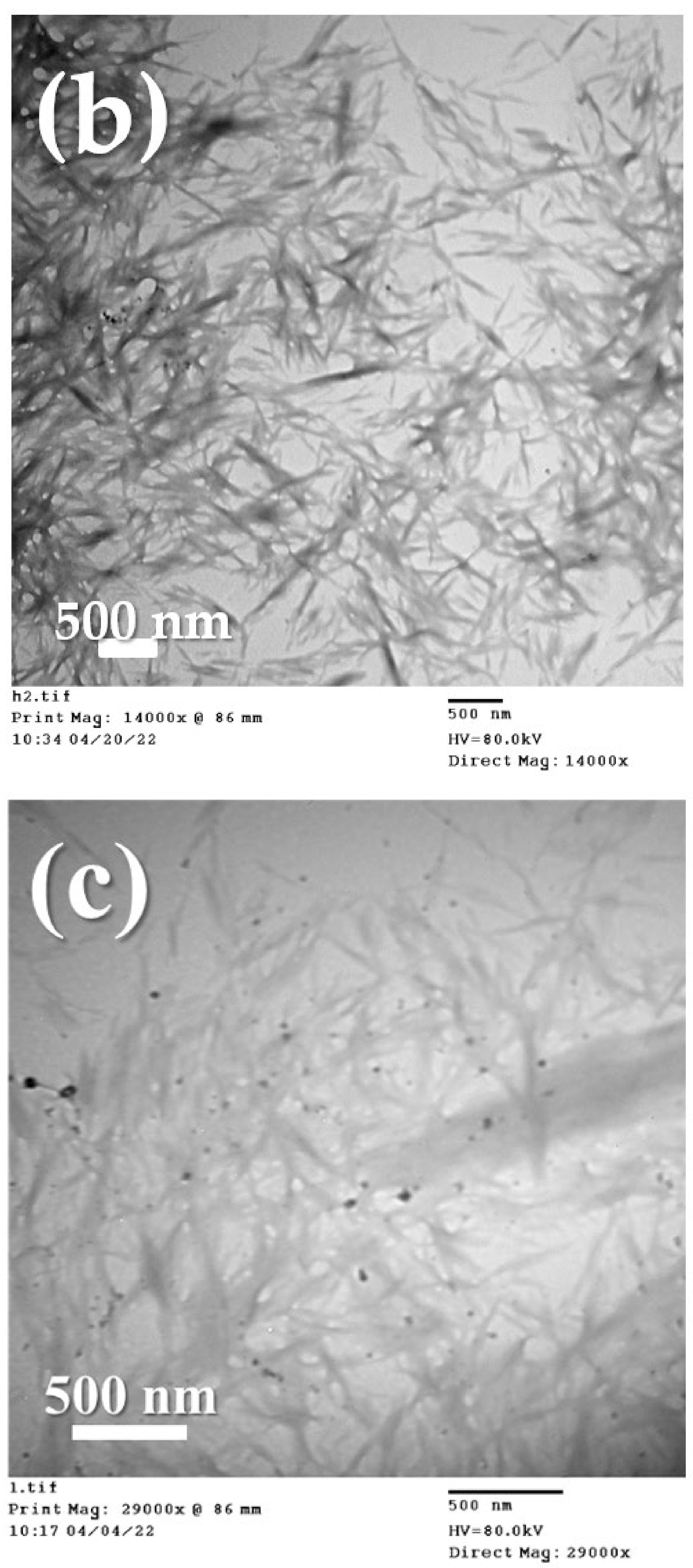
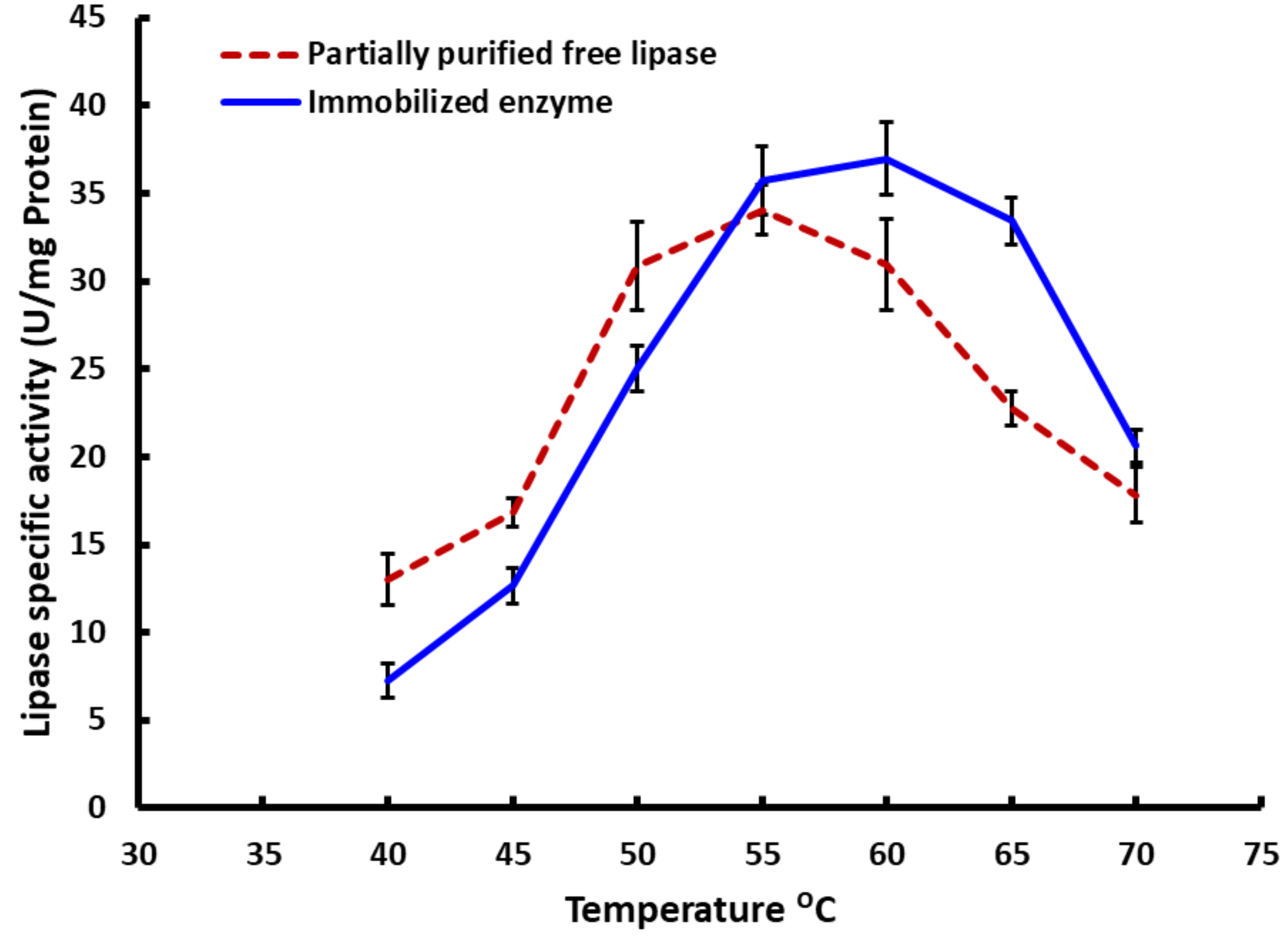
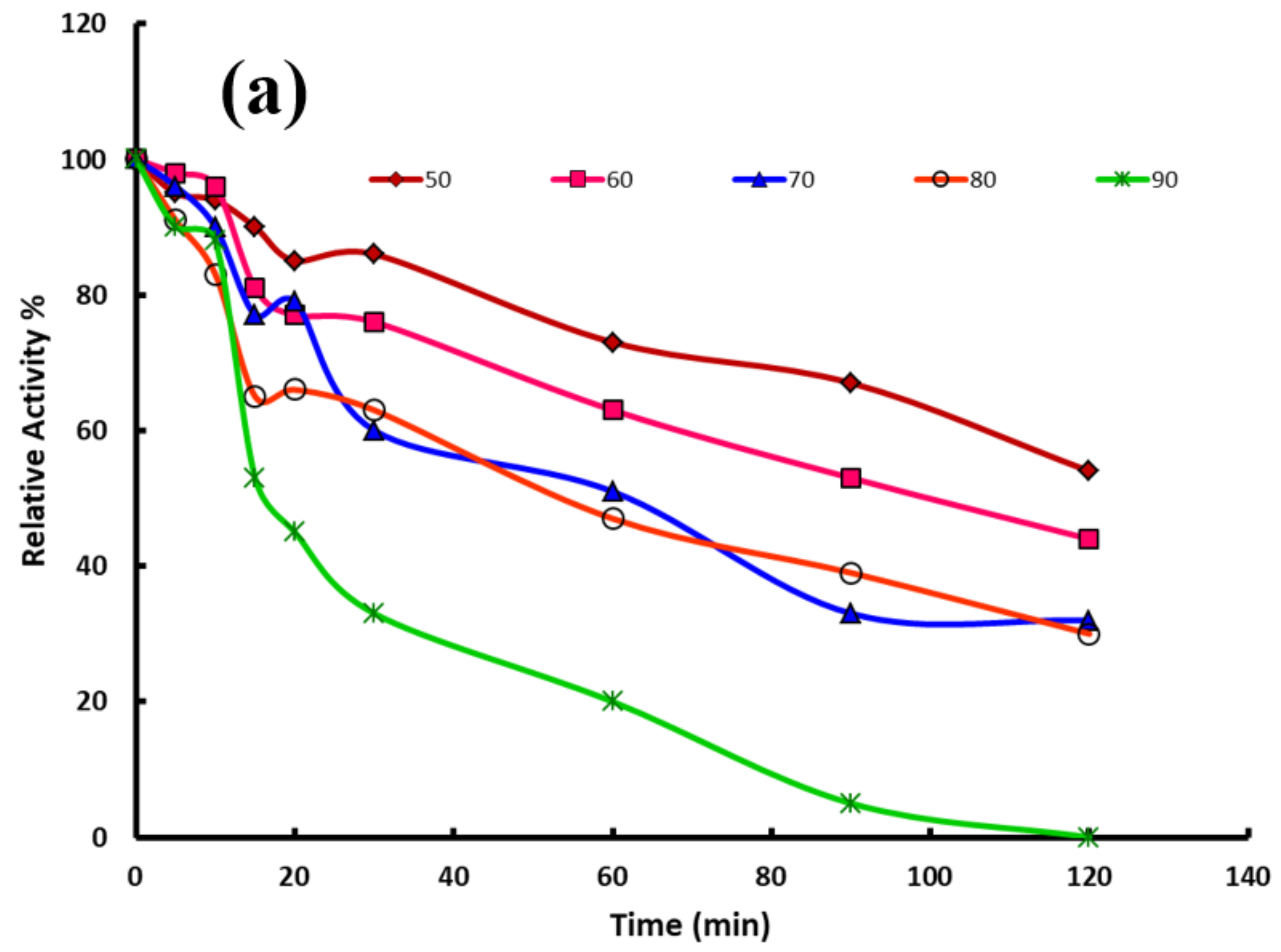

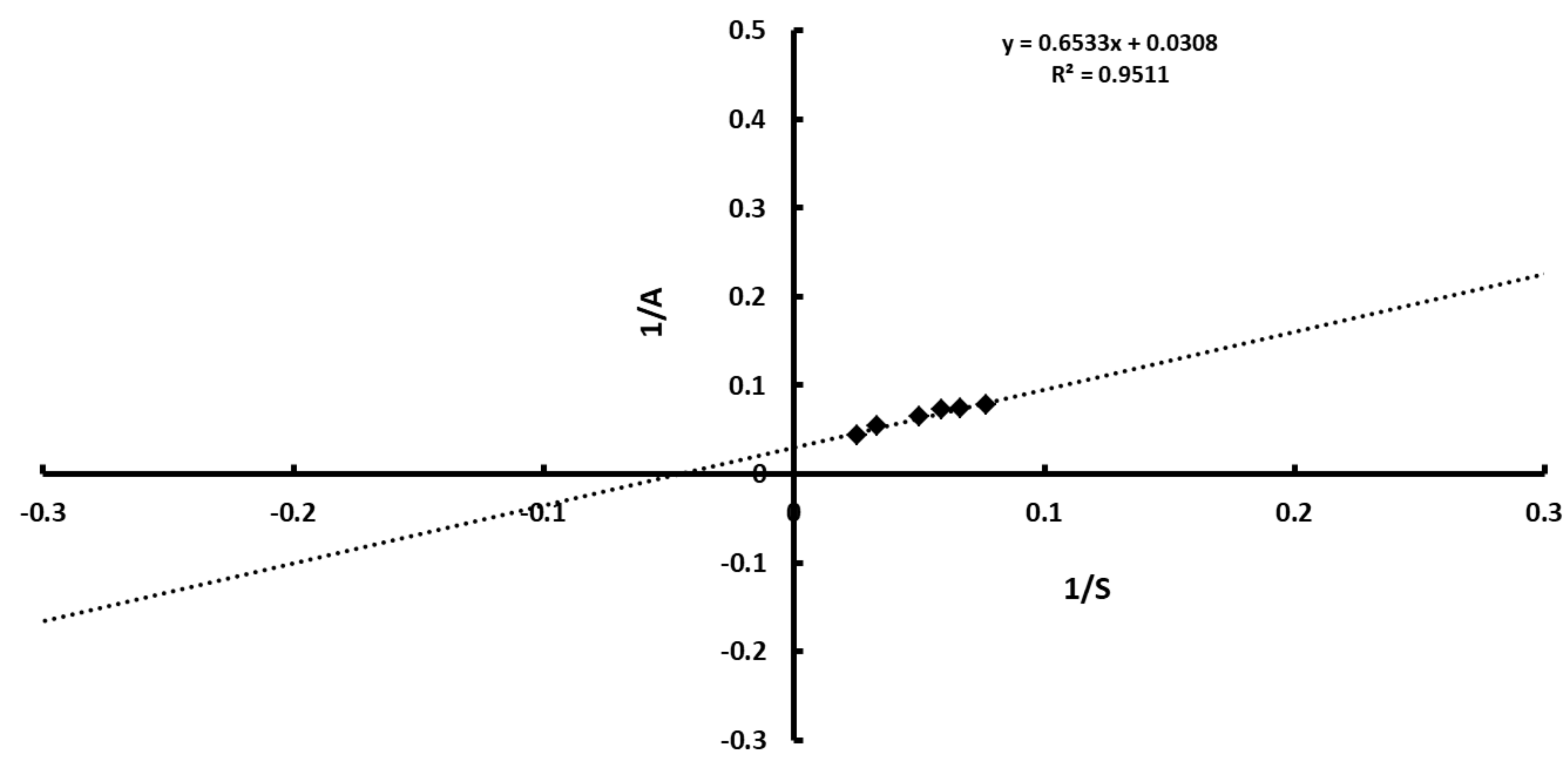


| Activity (U/mL) | Protein Content (mg/mL) | Specific Activity U/mg Protein | |
|---|---|---|---|
| Crude enzyme | 15.03 ± 0.62 | 0.45 ± 0.32 | 33.35 ± 1.94 |
| Partially purified enzyme | 25.24 ± 2.03 | 0.65 ± 0.98 | 38.83 ± 2.07 |
| pH | Enzyme Specific Activity (U/mg Protein) | |
|---|---|---|
| Partially Purified Free Lipase | Immobilized Enzyme | |
| 4 | 11.49 ± 1.96 | 9.04 ± 0.45 |
| 5 | 21.73 ± 1.83 | 20.32 ± 1.13 |
| 6 | 26.49 ± 4.01 | 27.93 ± 0.55 |
| 7 | 30.26 ± 1.85 | 34.87 ± 0.45 |
| 8 | 35.87 ± 2.25 | 39.7 ± 1.4 |
| 9 | 20.71 ± 0.43 | 32.53 ± 0.97 |
| Property | Value | Standard | |
|---|---|---|---|
| US Biodiesel Standard ASTM D6751 | EU Biodiesel Standard EN 14214 | ||
| Density (g.cm−3) | 0.642 | NS | 0.86–0.90 |
| Kinematic viscosity (40 °C; mm2 s−1) | 3.6 | 1.9–6.0 | 3.5–5.0 |
| SN | 128.69 | NS | NS |
| IV | 33.74 | NS | 120 max |
| HHV (MJ kg−1) | 43.65 | NS | NS |
| CN | 59.02 | 47–65 | 51 min |
| FFA (%) | 5.98 | NS | NS |
| Concentration of linolenic acid (C18:2) (%) | 3.24 | NS | 12 max |
| FAME having ≥4 double bonds (%) | ND | NS | 1 max |
Publisher’s Note: MDPI stays neutral with regard to jurisdictional claims in published maps and institutional affiliations. |
© 2022 by the authors. Licensee MDPI, Basel, Switzerland. This article is an open access article distributed under the terms and conditions of the Creative Commons Attribution (CC BY) license (https://creativecommons.org/licenses/by/4.0/).
Share and Cite
Najjar, A.A.; Hassan, E.A.; Zabermawi, N.M.; Almasaudi, S.B.; Moulay, M.; Harakeh, S.; Abd El-Aal, M. Efficacy of the Immobilized Kocuria flava Lipase on Fe3O4/Cellulose Nanocomposite for Biodiesel Production from Cooking Oil Wastes. Catalysts 2022, 12, 977. https://doi.org/10.3390/catal12090977
Najjar AA, Hassan EA, Zabermawi NM, Almasaudi SB, Moulay M, Harakeh S, Abd El-Aal M. Efficacy of the Immobilized Kocuria flava Lipase on Fe3O4/Cellulose Nanocomposite for Biodiesel Production from Cooking Oil Wastes. Catalysts. 2022; 12(9):977. https://doi.org/10.3390/catal12090977
Chicago/Turabian StyleNajjar, Azhar A., Elhagag A. Hassan, Nidal M. Zabermawi, Saad B. Almasaudi, Mohammed Moulay, Steve Harakeh, and Mohamed Abd El-Aal. 2022. "Efficacy of the Immobilized Kocuria flava Lipase on Fe3O4/Cellulose Nanocomposite for Biodiesel Production from Cooking Oil Wastes" Catalysts 12, no. 9: 977. https://doi.org/10.3390/catal12090977
APA StyleNajjar, A. A., Hassan, E. A., Zabermawi, N. M., Almasaudi, S. B., Moulay, M., Harakeh, S., & Abd El-Aal, M. (2022). Efficacy of the Immobilized Kocuria flava Lipase on Fe3O4/Cellulose Nanocomposite for Biodiesel Production from Cooking Oil Wastes. Catalysts, 12(9), 977. https://doi.org/10.3390/catal12090977







